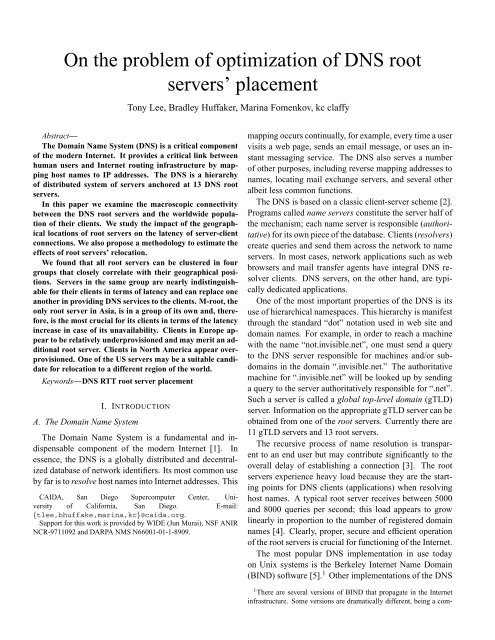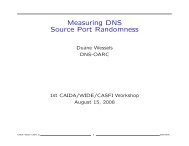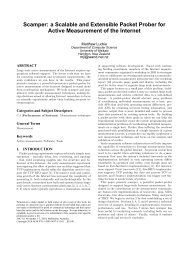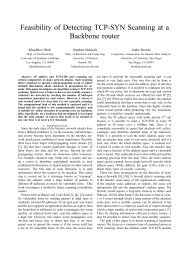On the problem of optimization of DNS root servers' placement - Caida
On the problem of optimization of DNS root servers' placement - Caida
On the problem of optimization of DNS root servers' placement - Caida
- No tags were found...
You also want an ePaper? Increase the reach of your titles
YUMPU automatically turns print PDFs into web optimized ePapers that Google loves.
<strong>On</strong> <strong>the</strong> <strong>problem</strong> <strong>of</strong> <strong>optimization</strong> <strong>of</strong> <strong>DNS</strong> <strong>root</strong><br />
servers’ <strong>placement</strong><br />
Tony Lee, Bradley Huffaker, Marina Fomenkov, kc claffy<br />
Abstract—<br />
The Domain Name System (<strong>DNS</strong>) is a critical component<br />
<strong>of</strong> <strong>the</strong> modern Internet. It provides a critical link between<br />
human users and Internet routing infrastructure by mapping<br />
host names to IP addresses. The <strong>DNS</strong> is a hierarchy<br />
<strong>of</strong> distributed system <strong>of</strong> servers anchored at 13 <strong>DNS</strong> <strong>root</strong><br />
servers.<br />
In this paper we examine <strong>the</strong> macroscopic connectivity<br />
between <strong>the</strong> <strong>DNS</strong> <strong>root</strong> servers and <strong>the</strong> worldwide population<br />
<strong>of</strong> <strong>the</strong>ir clients. We study <strong>the</strong> impact <strong>of</strong> <strong>the</strong> geographical<br />
locations <strong>of</strong> <strong>root</strong> servers on <strong>the</strong> latency <strong>of</strong> server-client<br />
connections. We also propose a methodology to estimate <strong>the</strong><br />
effects <strong>of</strong> <strong>root</strong> servers’ relocation.<br />
We found that all <strong>root</strong> servers can be clustered in four<br />
groups that closely correlate with <strong>the</strong>ir geographical positions.<br />
Servers in <strong>the</strong> same group are nearly indistinguishable<br />
for <strong>the</strong>ir clients in terms <strong>of</strong> latency and can replace one<br />
ano<strong>the</strong>r in providing <strong>DNS</strong> services to <strong>the</strong> clients. M-<strong>root</strong>, <strong>the</strong><br />
only <strong>root</strong> server in Asia, is in a group <strong>of</strong> its own and, <strong>the</strong>refore,<br />
is <strong>the</strong> most crucial for its clients in terms <strong>of</strong> <strong>the</strong> latency<br />
increase in case <strong>of</strong> its unavailability. Clients in Europe appear<br />
to be relatively underprovisioned and may merit an additional<br />
<strong>root</strong> server. Clients in North America appear overprovisioned.<br />
<strong>On</strong>e <strong>of</strong> <strong>the</strong> US servers may be a suitable candidate<br />
for relocation to a different region <strong>of</strong> <strong>the</strong> world.<br />
Keywords—<strong>DNS</strong> RTT <strong>root</strong> server <strong>placement</strong><br />
I. INTRODUCTION<br />
A. The Domain Name System<br />
The Domain Name System is a fundamental and indispensable<br />
component <strong>of</strong> <strong>the</strong> modern Internet [1]. In<br />
essence, <strong>the</strong> <strong>DNS</strong> is a globally distributed and decentralized<br />
database <strong>of</strong> network identifiers. Its most common use<br />
by far is to resolve host names into Internet addresses. This<br />
CAIDA, San Diego Supercomputer Center, University<br />
<strong>of</strong> California, San Diego. E-mail:<br />
{tlee,bhuffake,marina,kc}@caida.org.<br />
Support for this work is provided by WIDE (Jun Murai), NSF ANIR<br />
NCR-9711092 and DARPA NMS N66001-01-1-8909.<br />
mapping occurs continually, for example, every time a user<br />
visits a web page, sends an email message, or uses an instant<br />
messaging service. The <strong>DNS</strong> also serves a number<br />
<strong>of</strong> o<strong>the</strong>r purposes, including reverse mapping addresses to<br />
names, locating mail exchange servers, and several o<strong>the</strong>r<br />
albeit less common functions.<br />
The <strong>DNS</strong> is based on a classic client-server scheme [2].<br />
Programs called name servers constitute <strong>the</strong> server half <strong>of</strong><br />
<strong>the</strong> mechanism; each name server is responsible (authoritative)<br />
for its own piece <strong>of</strong> <strong>the</strong> database. Clients (resolvers)<br />
create queries and send <strong>the</strong>m across <strong>the</strong> network to name<br />
servers. In most cases, network applications such as web<br />
browsers and mail transfer agents have integral <strong>DNS</strong> resolver<br />
clients. <strong>DNS</strong> servers, on <strong>the</strong> o<strong>the</strong>r hand, are typically<br />
dedicated applications.<br />
<strong>On</strong>e <strong>of</strong> <strong>the</strong> most important properties <strong>of</strong> <strong>the</strong> <strong>DNS</strong> is its<br />
use <strong>of</strong> hierarchical namespaces. This hierarchy is manifest<br />
through <strong>the</strong> standard “dot” notation used in web site and<br />
domain names. For example, in order to reach a machine<br />
with <strong>the</strong> name “not.invisible.net”, one must send a query<br />
to <strong>the</strong> <strong>DNS</strong> server responsible for machines and/or subdomains<br />
in <strong>the</strong> domain “.invisible.net.” The authoritative<br />
machine for “.invisible.net” will be looked up by sending<br />
a query to <strong>the</strong> server authoritatively responsible for “.net”.<br />
Such a server is called a global top-level domain (gTLD)<br />
server. Information on <strong>the</strong> appropriate gTLD server can be<br />
obtained from one <strong>of</strong> <strong>the</strong> <strong>root</strong> servers. Currently <strong>the</strong>re are<br />
11 gTLD servers and 13 <strong>root</strong> servers.<br />
The recursive process <strong>of</strong> name resolution is transparent<br />
to an end user but may contribute significantly to <strong>the</strong><br />
overall delay <strong>of</strong> establishing a connection [3]. The <strong>root</strong><br />
servers experience heavy load because <strong>the</strong>y are <strong>the</strong> starting<br />
points for <strong>DNS</strong> clients (applications) when resolving<br />
host names. A typical <strong>root</strong> server receives between 5000<br />
and 8000 queries per second; this load appears to grow<br />
linearly in proportion to <strong>the</strong> number <strong>of</strong> registered domain<br />
names [4]. Clearly, proper, secure and efficient operation<br />
<strong>of</strong> <strong>the</strong> <strong>root</strong> servers is crucial for functioning <strong>of</strong> <strong>the</strong> Internet.<br />
The most popular <strong>DNS</strong> implementation in use today<br />
on Unix systems is <strong>the</strong> Berkeley Internet Name Domain<br />
(BIND) s<strong>of</strong>tware [5]. 1 O<strong>the</strong>r implementations <strong>of</strong> <strong>the</strong> <strong>DNS</strong><br />
1 There are several versions <strong>of</strong> BIND that propagate in <strong>the</strong> Internet<br />
infrastructure. Some versions are dramatically different, being a com-
2<br />
specifications are also available, including djbdns [6], and<br />
Micros<strong>of</strong>t’s <strong>DNS</strong> s<strong>of</strong>tware bundled with its Windows operating<br />
systems [7].<br />
Figure 1 shows <strong>the</strong> locations <strong>of</strong> existing <strong>root</strong> servers<br />
around <strong>the</strong> world. The geographical distribution is highly<br />
uneven, with six <strong>root</strong> servers on <strong>the</strong> US East coast, four on<br />
<strong>the</strong> US West coast, two in Europe, and one in Japan. Each<br />
<strong>DNS</strong> <strong>root</strong> server is administered independently by a separate<br />
organization and uses diverse types <strong>of</strong> hardware and<br />
operating systems.<br />
Numerous organizations are interested in hosting a <strong>root</strong><br />
name server since it brings prestige and, to some extent,<br />
control. The Root Server Selection Advisory Committee<br />
(RSSAC) is a technical advisory committee for <strong>the</strong> Internet<br />
Corporation for Assigned Names and Numbers (ICANN).<br />
<strong>On</strong>e <strong>of</strong> its responsibilities is to advise ICANN on <strong>the</strong> <strong>placement</strong><br />
<strong>of</strong> future <strong>root</strong> name servers. <strong>On</strong> behalf <strong>of</strong> RSSAC,<br />
CAIDA is ga<strong>the</strong>ring measurement data to help determine<br />
architecturally strategic locations and to provide unbiased<br />
recommendations on optimal servers’ <strong>placement</strong> [8].<br />
San Francisco ( E, F )<br />
London ( K )<br />
Washington DC ( A, C*, D, G, H, J )<br />
Los Angeles ( B, L *)<br />
*<br />
Stockholm ( I )<br />
Tokyo ( M )<br />
Fig. 1. The geographic locations <strong>of</strong> <strong>DNS</strong> <strong>root</strong> servers. Servers<br />
marked with ‘*’ currently do not have co-located CAIDA skitter<br />
monitors.<br />
B. Related work<br />
The indispensable role <strong>of</strong> <strong>the</strong> <strong>DNS</strong> in Internet functioning<br />
and its unparalleled scale prompted multiple studies<br />
<strong>of</strong> <strong>DNS</strong> performance per se [9], [10],[11],[12] and <strong>of</strong> its<br />
contribution to overall web performance [13],[3],[14]. In<br />
<strong>the</strong>se studies, measurements are usually taken at a limited<br />
number <strong>of</strong> locations in <strong>the</strong> Internet topology and analysis<br />
is focused on effects <strong>of</strong> errors in <strong>DNS</strong> implementations and<br />
on caching. In an ongoing project, Cho, et al. [15] monitor<br />
<strong>the</strong> <strong>DNS</strong> <strong>root</strong> name server performance from various<br />
parts <strong>of</strong> <strong>the</strong> Internet by active probing. They seek to develop<br />
technical methods for assessing <strong>the</strong> <strong>root</strong> name server<br />
system performance and for planning its future reconfigurations.<br />
Liston, et al. [16] identified various <strong>DNS</strong> performance<br />
metrics (completion and success rates <strong>of</strong> resolving names,<br />
plete rewrite from scratch.<br />
<strong>the</strong> mean response time for completed lookups, <strong>the</strong> <strong>root</strong><br />
and gTLD servers that are favored by <strong>the</strong> sites, <strong>the</strong> distribution<br />
<strong>of</strong> TTLs across names), and studied location-related<br />
variations <strong>of</strong> <strong>the</strong>se metrics. The measurements were obtained<br />
from 75 different Internet locations in 21 countries.<br />
Liston, et al. conclude that <strong>the</strong> greatest performance enhancements<br />
can be achieved by reducing <strong>the</strong> response time<br />
<strong>of</strong> intermediate-level servers ra<strong>the</strong>r than <strong>the</strong> top-level <strong>root</strong><br />
and gTLD servers. They state, however, that a more equitable<br />
choice <strong>of</strong> <strong>placement</strong> <strong>of</strong> <strong>the</strong> gTLD servers in particular<br />
has <strong>the</strong> potential to signficantly affect user-perceived<br />
performance. Note that although <strong>the</strong> results presented in<br />
our paper deal with <strong>the</strong> <strong>placement</strong> <strong>of</strong> <strong>the</strong> <strong>root</strong> servers, our<br />
measurements and approach can be expanded to evaluate<br />
<strong>the</strong> gTLD servers as well.<br />
O<strong>the</strong>r studies have considered <strong>the</strong> <strong>DNS</strong> in conjunction<br />
with <strong>the</strong> more general <strong>problem</strong> <strong>of</strong> nearest server selection.<br />
Shaikh, et al. [17] evaluated <strong>the</strong> effectiveness <strong>of</strong><br />
<strong>DNS</strong>-based server selection. They found that <strong>DNS</strong>-based<br />
schemes typically disable client-side caching <strong>of</strong> name resolution<br />
results. The negative consequences <strong>of</strong> this policy<br />
are two-fold: a) considerable increase <strong>of</strong> name resolution<br />
overhead for <strong>the</strong> client, especially when <strong>the</strong> number <strong>of</strong> embedded<br />
objects, e.g., images and advertisements, served<br />
from multiple sources increases; b) growth <strong>of</strong> <strong>the</strong> number<br />
<strong>of</strong> queries to authoritative <strong>DNS</strong> servers and <strong>the</strong> network<br />
traffic incurred by <strong>the</strong>se queries. Shaikh, et al. propose<br />
modifications to <strong>the</strong> <strong>DNS</strong> protocol to improve <strong>the</strong> accuracy<br />
<strong>of</strong> <strong>the</strong> <strong>DNS</strong>-based server selection technique.<br />
Somegawa, et al. [18] examined server selection mechanisms<br />
employed by different <strong>DNS</strong> implementations (reciprocal<br />
algorithm in BIND-8, best server in BIND-9, uniform<br />
algorithm in djbdns and Windows 2000) 2 as a case<br />
study for <strong>the</strong> general <strong>problem</strong> <strong>of</strong> best server <strong>placement</strong> and<br />
selection. They used data collected by Cho, et al. [15] and<br />
simulated effects <strong>of</strong> different server selection mechanisms.<br />
Somegawa, et al. found that <strong>the</strong> reciprocal algorithm is<br />
more suitable for <strong>the</strong> Internet environment than <strong>the</strong> o<strong>the</strong>r<br />
two currently implemented algorithms. They also showed<br />
that <strong>the</strong> proper use <strong>of</strong> server selection algorithms is essential<br />
for <strong>the</strong> stability <strong>of</strong> <strong>the</strong> <strong>DNS</strong> service.<br />
A. Data collection<br />
II. METHODOLOGY<br />
For this study we use <strong>the</strong> data obtained as part <strong>of</strong><br />
CAIDA’s macroscopic topology probing project [19].<br />
2 The reciprocal algorithm selects a server with a probability reciprocal<br />
to a certain metric. The best server algorithm chooses a server<br />
with <strong>the</strong> best metric. The uniform algorithm selects each server with<br />
uniform probability.
3<br />
CAIDA has deployed its topology probing tool skitter<br />
[20] at hosts co-located with <strong>the</strong> <strong>DNS</strong> <strong>root</strong> servers.<br />
At <strong>the</strong> time <strong>of</strong> this study we have instrumented 11 out <strong>of</strong><br />
13 <strong>root</strong> servers; at this time A and J <strong>root</strong>s were co-located<br />
(<strong>the</strong>y no longer are) and so shared a monitor. The administration<br />
<strong>of</strong> <strong>the</strong> C <strong>root</strong> server has not responded to our request<br />
to host a skitter monitor at <strong>the</strong>ir site. The monitor deployed<br />
at <strong>the</strong> L <strong>root</strong> server has had intermittent troubles.<br />
The skitter tool actively measures connectivity and<br />
performance <strong>of</strong> <strong>the</strong> network between <strong>the</strong> monitor host and<br />
a pre-determined target list <strong>of</strong> destinations. It iteratively<br />
sends 52-byte ICMP echo request packets, incrementally<br />
increasing <strong>the</strong>ir time-to-live values until a packet reaches<br />
<strong>the</strong> target host. Each trace is a record <strong>of</strong> <strong>the</strong> IP addresses <strong>of</strong><br />
responding intermediate routers on <strong>the</strong> forward path from<br />
<strong>the</strong> source to <strong>the</strong> target destination, as well as <strong>the</strong> roundtrip<br />
time (RTT) to <strong>the</strong> destination. Such measurements,<br />
typically made from 1 to 15 times daily (<strong>the</strong> frequency<br />
depending primarily on <strong>the</strong> size <strong>of</strong> <strong>the</strong> list), characterize<br />
macroscopic connectivity between <strong>the</strong> topology monitor<br />
and <strong>the</strong> destination hosts on its probe list.<br />
B. Target list<br />
In order to study <strong>the</strong> global connectivity <strong>of</strong> <strong>the</strong> <strong>root</strong><br />
servers to <strong>the</strong>ir clients, we needed a representative target<br />
list. Ideally we would like to monitor a destination in each<br />
/24 prefix, but this is impossible. We attempted to find a<br />
destination in each globally routable prefix 3 from a vast<br />
pool <strong>of</strong> IP addresses sending messages to <strong>the</strong> <strong>DNS</strong> <strong>root</strong><br />
name servers. We also restricted <strong>the</strong> size <strong>of</strong> <strong>the</strong> target list to<br />
between 100 and 200 thousand addresses. The size restriction<br />
ensures that a typical topology monitor polls each destinations<br />
at least 3-5 times in a 24 hour period thus making<br />
RTT measurements less sensitive to diurnal variations, but<br />
avoiding over-sampling.<br />
We used <strong>the</strong> CAIDA dnsstat utility [22] to passively<br />
monitor <strong>DNS</strong> queries at <strong>the</strong> A, D, E, F, H, I, K, and M <strong>root</strong><br />
servers. <strong>On</strong> each <strong>root</strong> server, numbers <strong>of</strong> messages and<br />
number <strong>of</strong> queries (but not <strong>the</strong> subjects <strong>of</strong> queries) were<br />
counted for 24 hours and recorded toge<strong>the</strong>r with source IP<br />
addresses originating <strong>the</strong>se messages. These aggregated<br />
statistics yielded nearly 2 million client addresses representing,<br />
however, only about 52K routable prefixes out<br />
<strong>of</strong> 118K prefixes in <strong>the</strong> BGP table from March 18, 2002.<br />
Therefore we could afford to increase <strong>the</strong> coverage <strong>of</strong> large<br />
prefixes still within <strong>the</strong> optimal list size. In order to add<br />
destinations uniformly across <strong>the</strong> IPv4 space, we started<br />
by splitting each /8 prefix into two /9 prefixes and search-<br />
3 We consider a prefix ‘globally routable’ if it is present in <strong>the</strong> combined<br />
Route Views BGP table [21] at <strong>the</strong> time we compiled <strong>the</strong> destination<br />
list.<br />
ing for a destination in each half. We <strong>the</strong>n repeated this<br />
process by splitting each /9 prefix into two /10 prefixes,<br />
and so on, and counting available addresses at each level<br />
<strong>of</strong> granularity.<br />
We made our final selection <strong>of</strong> destinations when we<br />
reached <strong>the</strong> /21 level because <strong>the</strong> number <strong>of</strong> hosts available<br />
at <strong>the</strong> next level /22 exceeded our desired limit. If<br />
multiple destinations in <strong>the</strong> same prefix were present in<br />
<strong>the</strong> collected dnsstat files, we selected one based on<br />
<strong>the</strong> following criteria:<br />
• prefer IP addresses from <strong>the</strong> old <strong>DNS</strong> Clients list used in<br />
our previous <strong>DNS</strong> related studies in 2000-2001 [23], [24].<br />
• prefer IP addresses seen by <strong>the</strong> largest number <strong>of</strong> <strong>the</strong><br />
<strong>DNS</strong> <strong>root</strong> servers.<br />
The resulting <strong>DNS</strong> Clients list has about 140K destinations.<br />
We have been monitoring this list since <strong>the</strong> end <strong>of</strong><br />
March 2002.<br />
C. RTT measurements<br />
When a client addresses a <strong>root</strong> server with a request, <strong>the</strong><br />
response time is a sum <strong>of</strong> two components: <strong>the</strong> RTT between<br />
<strong>the</strong> client and <strong>the</strong> server, and <strong>the</strong> request processing<br />
time. Several o<strong>the</strong>r studies have considered <strong>the</strong> actual response<br />
time <strong>of</strong> <strong>the</strong> <strong>DNS</strong> <strong>root</strong>s [3],[10],[11]. In this paper<br />
we focus strictly on <strong>the</strong> RTT component that is due to <strong>the</strong><br />
packet propagation in <strong>the</strong> infrastructure. We have examined<br />
how <strong>the</strong> location (both geographical and virtual) <strong>of</strong><br />
<strong>root</strong> servers with respect to <strong>the</strong>ir clients affects <strong>the</strong> latency<br />
<strong>of</strong> client-server connections.<br />
Our analysis is based on <strong>the</strong> following assumptions.<br />
1. Although <strong>the</strong> size <strong>of</strong> <strong>the</strong> <strong>DNS</strong> Clients list is tiny in comparison<br />
with <strong>the</strong> total number <strong>of</strong> name servers in <strong>the</strong> Internet,<br />
this list is representative <strong>of</strong> <strong>the</strong> overall population <strong>of</strong><br />
<strong>the</strong> <strong>root</strong> servers’ clients. Therefore, our conclusions drawn<br />
from measuring <strong>the</strong> limited sample <strong>of</strong> clients are arguably<br />
representative <strong>of</strong> <strong>the</strong> global <strong>DNS</strong> system.<br />
2. RTTs collected by our topology monitors for probe<br />
ICMP packets are approximately <strong>the</strong> same as <strong>DNS</strong> response<br />
times actually experienced by <strong>root</strong> servers’ clients.<br />
This approximation is valid if <strong>the</strong> request processing time<br />
is small in comparison with <strong>the</strong> propagation time. Measurements<br />
comparing <strong>the</strong> ICMP probe RTT and <strong>the</strong> <strong>DNS</strong><br />
response times are available at [25]. Both times seem to be<br />
in sufficient agreement to validate this assumption.<br />
3. When choosing among <strong>root</strong> servers, a client selects <strong>the</strong><br />
<strong>root</strong> server with <strong>the</strong> lowest RTT and always addresses it<br />
with its <strong>DNS</strong> requests. If this best server becomes unavailable,<br />
<strong>the</strong> client switches to <strong>the</strong> second best and so on, <strong>the</strong><br />
rank number increasing in <strong>the</strong> increasing order <strong>of</strong> RTTs.<br />
This assumption is a simplification <strong>of</strong> <strong>the</strong> actual algorithm<br />
for server selection used by BIND, which makes sure that
4<br />
eventually a client will address all <strong>root</strong> servers, not only<br />
<strong>the</strong> best one with <strong>the</strong> shortest response time. However, <strong>the</strong><br />
best server will be used most frequently. This property <strong>of</strong><br />
<strong>the</strong> BIND algorithm lends credibility to our approach.<br />
4. Our topology monitors normally collect three values<br />
<strong>of</strong> RTT for each client in a 24 hour period. We use median<br />
RTT as a representative metric <strong>of</strong> <strong>the</strong> latency between<br />
clients and <strong>root</strong> servers. Generally, RTTs are influenced<br />
by diurnal network patterns and by multiple random<br />
short-lived factors (e.g., link congestion, queuing, routing<br />
changes). However, we have shown [24] that <strong>the</strong> median<br />
RTT derived from a certain set <strong>of</strong> previously observed values<br />
is a stable and reliable metric <strong>of</strong> <strong>the</strong> proximity between<br />
two Internet hosts. 4 While prior information can not predict<br />
<strong>the</strong> absolute value <strong>of</strong> RTT, it consistently achieves a<br />
high positive correlation to <strong>the</strong> current latency <strong>of</strong> a connection.<br />
III. RESULTS<br />
We have analyzed one week <strong>of</strong> traces collected by topology<br />
monitors co-located with <strong>the</strong> A, B, D, E, F, G, H, I, K,<br />
and M <strong>root</strong> servers from July 14 to July 20, 2002. At that<br />
time, about 108.5K destinations in our list were responding<br />
to skitter ICMP probes. 5 For each replying destinations,<br />
our monitors collected between 3 and 7 RTTs per<br />
day.<br />
A. Significance <strong>of</strong> individual <strong>root</strong> servers<br />
BIND implements an affinity algorithm that causes<br />
client name servers to select intelligently among all available<br />
<strong>root</strong> servers. It chooses a random starting point, cycles<br />
through <strong>the</strong> <strong>root</strong> servers, remembering <strong>the</strong> response<br />
time for each, and sorts <strong>the</strong> <strong>root</strong> servers into groups based<br />
on <strong>the</strong> observed values <strong>of</strong> RTT. Subsequent queries are directed<br />
to servers in <strong>the</strong> closest group in a round robin fashion.<br />
As a result, a client that is ‘close’ (in terms <strong>of</strong> latency)<br />
to a particular <strong>root</strong> server will query that server most <strong>of</strong> <strong>the</strong><br />
time, only occasionally querying o<strong>the</strong>r <strong>root</strong> servers that are<br />
fur<strong>the</strong>r away. Accordingly, each <strong>root</strong> server acquires a set<br />
<strong>of</strong> client hosts who prefer its services over those <strong>of</strong> o<strong>the</strong>r<br />
<strong>root</strong>s.<br />
Should a <strong>root</strong> server become unavailable, its clients<br />
would experience an increase in response time to <strong>the</strong>ir<br />
<strong>DNS</strong> requests related to how far <strong>the</strong> ‘second closest’ <strong>root</strong><br />
server is from each client. We analyze a <strong>root</strong> server’s ‘importance’<br />
based on <strong>the</strong> greater <strong>the</strong> number <strong>of</strong> clients who<br />
4 Defined as <strong>the</strong> latency <strong>of</strong> connection between <strong>the</strong>se hosts.<br />
5 From our previous experience with monitoring <strong>of</strong> o<strong>the</strong>r destination<br />
lists, we know that <strong>the</strong> number <strong>of</strong> replying destinations decreases with<br />
time at a typical decay rate <strong>of</strong> 2-3% per month. [26]<br />
would experience increased latency in such a situation, and<br />
<strong>the</strong> magnitude <strong>of</strong> those increases.<br />
In our measurements, <strong>the</strong> topology monitors simulate<br />
<strong>root</strong> servers, and target destinations in <strong>the</strong> <strong>DNS</strong> Clients list<br />
represent <strong>the</strong> general population <strong>of</strong> clients. For each destination<br />
client n , n = 1..N in our list we did <strong>the</strong> following.<br />
From a week <strong>of</strong> data we determined median RTTs to each<br />
monitor {mRT T S i<br />
n }, i = 1..10, rounded <strong>the</strong>m to integers,<br />
and ranked <strong>the</strong>m in increasing order. The difference between<br />
<strong>the</strong> lowest RTT and <strong>the</strong> second lowest RTT is <strong>the</strong><br />
increased latency that this client would experience if its<br />
best (‘closest’ in latency) server became unavailable.<br />
∆RT T n = RT T<br />
second lowest<br />
n − RT Tn<br />
lowest<br />
We <strong>the</strong>n grouped destinations into ten subgroups by<br />
<strong>the</strong>ir best servers and calculated <strong>the</strong> complementary cumulative<br />
distribution functions (CCDFs) <strong>of</strong> {∆RT T n } in<br />
each subgroup (figure 2). Here <strong>the</strong> x-axis is <strong>the</strong> increase<br />
in latency; y(x) is <strong>the</strong> count <strong>of</strong> clients for which <strong>the</strong> increase<br />
in latency due to removal <strong>of</strong> <strong>the</strong>ir best <strong>root</strong> server is<br />
greater than x. The higher <strong>the</strong> curve, <strong>the</strong> more clients will<br />
be adversely affected by <strong>the</strong> removal <strong>of</strong> that server. In <strong>the</strong><br />
legend <strong>the</strong> servers are sorted by <strong>the</strong> average height <strong>of</strong> <strong>the</strong><br />
corresponding curves.<br />
number <strong>of</strong> clients<br />
20000<br />
15000<br />
10000<br />
5000<br />
2002/07/14 to 2002/07/20<br />
A A A A A A A A A A A A A A A A A A A A A A A A A A A A A<br />
A<br />
A<br />
A<br />
A<br />
A<br />
A<br />
A<br />
A<br />
A<br />
A<br />
A<br />
A<br />
A<br />
A<br />
A<br />
A<br />
A A A A A A A A A A A A A A A A A A A A A A<br />
0<br />
0 50 100 150 200<br />
delta RTT (ms)<br />
A<br />
m-<strong>root</strong> Tokyo, Japan<br />
k-<strong>root</strong> London, UK<br />
i-<strong>root</strong> Stockholm, Sweden<br />
f-<strong>root</strong> Palo Alto, US<br />
b-<strong>root</strong> Marina del Rey, US<br />
a&j-<strong>root</strong> Herndon, US<br />
d-<strong>root</strong> College Park, US<br />
g-<strong>root</strong> Vienna, US<br />
h-<strong>root</strong> Aberdeen, US<br />
e-<strong>root</strong> M<strong>of</strong>fett Field, US<br />
Fig. 2. Increase <strong>of</strong> latency caused by a <strong>root</strong> server removal. The<br />
curves are CCDFs <strong>of</strong> <strong>the</strong> number <strong>of</strong> clients.<br />
The M <strong>root</strong> server in Tokyo is <strong>the</strong> one with <strong>the</strong> highest<br />
curve. A steep drop <strong>of</strong> its CCDF at ∆RT T <strong>of</strong> about<br />
100 ms means that disabling <strong>the</strong> M <strong>root</strong> would cause a noticeable<br />
increase in latency <strong>of</strong> about 100 ms or more for<br />
<strong>the</strong> vast majority <strong>of</strong> its clients. Most o<strong>the</strong>r CCDF curves<br />
drop steeply at small values <strong>of</strong> ∆RT T . The faster a curve<br />
drops along <strong>the</strong> x-axis, <strong>the</strong> fewer clients <strong>of</strong> this <strong>root</strong> server<br />
are affected by its removal from service and <strong>the</strong> smaller in-<br />
A
5<br />
crease in latency <strong>the</strong>y would experience. For example, if E<br />
<strong>root</strong> or H <strong>root</strong> became unavailable, for 80% <strong>of</strong> <strong>the</strong>ir clients<br />
<strong>the</strong> increase <strong>of</strong> RTT would be less than 20 ms.<br />
It is not surprising that <strong>the</strong> M <strong>root</strong> server stands out in<br />
global importance since it is <strong>the</strong> only <strong>root</strong> server in Asia.<br />
Clients for which it is <strong>the</strong> best server are also most likely<br />
located in Asia (cf. [19], [24] about correlation between<br />
geographic distance and RTT) and thus are far from all<br />
o<strong>the</strong>r <strong>root</strong> servers. Without M <strong>root</strong> <strong>the</strong>ir <strong>DNS</strong> service<br />
would degrade significantly. However, if one <strong>of</strong> <strong>the</strong> <strong>root</strong><br />
servers in <strong>the</strong> US is down, <strong>the</strong> o<strong>the</strong>r US <strong>root</strong> servers are<br />
nearby and provide an acceptable backup with a minimal<br />
increase <strong>of</strong> RTT to <strong>the</strong> US clients.<br />
B. Root server clusters<br />
We have defined and studied <strong>the</strong> metric <strong>of</strong> distance between<br />
a given pair <strong>of</strong> <strong>root</strong> servers S 1 and S 2 . We consider a<br />
subset <strong>of</strong> destinations {client k }, k = 1..K that respond to<br />
both topology monitors co-located with <strong>the</strong>se servers. For<br />
each destination in this subset we find <strong>the</strong> median RTTs to<br />
each <strong>of</strong> <strong>the</strong> two monitors derived from a week <strong>of</strong> measurements:<br />
mRT T S 1<br />
k<br />
and mRT T S 2<br />
k<br />
. The distance between a<br />
pair <strong>of</strong> <strong>root</strong> servers D(S 1 , S 2 ) is:<br />
D(S 1 , S 2 ) = 1 K∑<br />
K ∣ mRT T S 1<br />
k<br />
− mRT T S 2<br />
k ∣ (1)<br />
k=1<br />
This metric measures <strong>the</strong> average absolute deviation between<br />
<strong>the</strong> two sets <strong>of</strong> RTTs and represents <strong>the</strong> virtual distance<br />
between <strong>the</strong> two <strong>root</strong> servers as viewed by <strong>the</strong> destinations<br />
in <strong>the</strong> <strong>DNS</strong> Clients list. The closer <strong>the</strong> resemblance<br />
between <strong>the</strong> two RTT distributions, <strong>the</strong> shorter <strong>the</strong><br />
distance, and <strong>the</strong> more indistinguishable in terms <strong>of</strong> latency<br />
variations <strong>the</strong>se servers are to <strong>the</strong> clients that have<br />
connectivity to both <strong>of</strong> <strong>the</strong>m.<br />
Next we identified clusters <strong>of</strong> <strong>the</strong> <strong>root</strong> servers based on<br />
<strong>the</strong>ir virtual proximity in terms <strong>of</strong> <strong>the</strong> metric above, and<br />
thus determined <strong>root</strong> server groups (”<strong>root</strong> families”). The<br />
resulting clusters (table I) satisfy two requirements:<br />
• For each server, its closest neighbor is always in <strong>the</strong><br />
same group.<br />
• All distances between members <strong>of</strong> <strong>the</strong> same group are<br />
lower than to members <strong>of</strong> o<strong>the</strong>r groups.<br />
Table I is diagonally symmetric. Four clusters <strong>of</strong> servers<br />
that we found in virtual space correlate remarkably well<br />
with <strong>the</strong> servers’ geographical location. Therefore <strong>the</strong><br />
name <strong>of</strong> each group reflects <strong>the</strong> smallest geographic region<br />
that includes all <strong>the</strong> servers in <strong>the</strong> same group.<br />
Servers in Group 1 (Europe) are less similar to each<br />
o<strong>the</strong>r than those in Group 2 and 3 (US), possibly because<br />
European servers are geographically more spread out. All<br />
servers <strong>of</strong> <strong>the</strong> group 2 (US-East) are very close to Washington<br />
DC, while all servers <strong>of</strong> <strong>the</strong> group 3 (US-West) are<br />
in California. The M <strong>root</strong> server is in a Group 4 <strong>of</strong> its own<br />
because it is geographically so remote from all o<strong>the</strong>r <strong>root</strong><br />
servers. Unsurprisingly, it appears that within each cluster,<br />
any one server can functionally replace ano<strong>the</strong>r one<br />
with <strong>the</strong> least RTT increase experienced by <strong>the</strong>ir clients.<br />
C. Root server clusters and <strong>the</strong>ir clients<br />
As previously mentioned, we assume that a client uses<br />
only its best server for lookups and if this server becomes<br />
unavailable, <strong>the</strong> client switches to <strong>the</strong> second best server.<br />
In Section III-B we found that servers attributed to <strong>the</strong><br />
same group are close to each o<strong>the</strong>r in virtual space and<br />
nearly indistinguishable to <strong>the</strong>ir clients in terms <strong>of</strong> connection<br />
latencies. Therefore if <strong>the</strong> best server <strong>of</strong> a particular<br />
client belongs to Group X and that group consists <strong>of</strong> more<br />
than one server, <strong>the</strong>n <strong>the</strong> second best server <strong>of</strong> this client<br />
most likely is in <strong>the</strong> same <strong>root</strong> family. In o<strong>the</strong>r words,<br />
a client depends primarily on <strong>root</strong> servers from a certain<br />
group for <strong>the</strong> <strong>DNS</strong> service.<br />
We subdivided all hosts in our target list into four subsets<br />
corresponding to four groups <strong>of</strong> <strong>root</strong> servers in Table<br />
I. We associated a host with a given group if its median<br />
RTT (derived from a week <strong>of</strong> observations) is lowest to<br />
one <strong>of</strong> <strong>the</strong> <strong>root</strong> servers in this group. Columns 1, 2, and<br />
3 in Table II show <strong>root</strong> families, <strong>the</strong> number <strong>of</strong> monitored<br />
<strong>root</strong> servers in each family, and <strong>the</strong> number <strong>of</strong> destinations<br />
in <strong>the</strong> subset associated with this family.<br />
We <strong>the</strong>n studied <strong>the</strong> geographical distribution <strong>of</strong> clients<br />
in each subset. We used <strong>the</strong> commercially available tool<br />
IxMapper [27] in order to determine <strong>the</strong> geographic location<br />
<strong>of</strong> each host in our target list. Figure 3 shows <strong>the</strong><br />
distribution <strong>of</strong> <strong>the</strong> four subsets <strong>of</strong> destinations by continents<br />
and countries. The left column lists <strong>the</strong> four <strong>root</strong><br />
families. Each horizontal bar is colored by continents and,<br />
when space allows, names <strong>the</strong> largest contributing countries<br />
within each continent. Note that <strong>the</strong> IxMapper’s<br />
<strong>placement</strong> can be imprecise (cf. discussion in [24]). The<br />
proposed location is obviously wrong if <strong>the</strong> RTT from at<br />
least one <strong>of</strong> our topology monitors to this destination is<br />
lower than <strong>the</strong> propagation time <strong>of</strong> <strong>the</strong> speed <strong>of</strong> light in<br />
fiber. This <strong>problem</strong> tarnished about 10% <strong>of</strong> destinations in<br />
<strong>the</strong> <strong>DNS</strong> Clients list and <strong>the</strong>y were excluded from Figure<br />
3.<br />
As expected, we found a strong correlation between<br />
<strong>the</strong> geographical location <strong>of</strong> clients and <strong>the</strong> geographical<br />
group <strong>of</strong> servers <strong>the</strong>y prefer (i.e. have lowest RTTs to).<br />
The clients <strong>of</strong> one <strong>root</strong> family tend to be geographically<br />
closer to servers in that group than to <strong>the</strong> o<strong>the</strong>rs. This cor-
6<br />
Group 1 Group 2 Group 3 Group 4<br />
Europe US-East US-West Tokyo, Japan<br />
k-<strong>root</strong> i-<strong>root</strong> a&j-<strong>root</strong> g-<strong>root</strong> h-<strong>root</strong> d-<strong>root</strong> f-<strong>root</strong> e-<strong>root</strong> b-<strong>root</strong> m-<strong>root</strong><br />
k-<strong>root</strong> 0.0 128.6 191.7 171.0 154.7 151.6 161.1 176.2 194.6 235.7<br />
i-<strong>root</strong> 128.6 0.0 167.2 174.9 172.4 170.1 181.1 182.7 190.8 232.7<br />
a&j-<strong>root</strong> 191.7 167.2 0.0 96.5 98.1 97.7 132.6 134.8 141.7 251.9<br />
g-<strong>root</strong> 171.0 174.9 96.5 0.0 95.5 91.5 128.4 133.5 134.0 231.6<br />
h-<strong>root</strong> 154.7 172.4 98.1 95.5 0.0 91.5 115.0 120.3 135.9 225.0<br />
d-<strong>root</strong> 151.6 170.1 97.7 91.5 91.5 0.0 128.3 127.3 138.5 229.3<br />
f-<strong>root</strong> 161.1 181.1 132.6 128.4 115.0 128.3 0.0 90.2 95.9 196.8<br />
e-<strong>root</strong> 176.2 182.7 134.8 133.5 120.3 127.3 90.2 0.0 104.2 209.7<br />
b-<strong>root</strong> 194.6 190.8 141.7 134.0 135.9 138.5 95.9 104.2 0.0 206.1<br />
m-<strong>root</strong> 235.7 232.7 251.9 231.6 225.0 229.3 196.8 209.7 206.1 0.0<br />
TABLE I<br />
ROOT FAMILIES.<br />
Groups Monitored <strong>root</strong>s servers Destinations preferred All <strong>root</strong> servers<br />
1. Europe 2 (18.2%) 24,387 (23.7%) 2 (15.4%)<br />
2. US-East 5 (45.5%) 42,978 (41.7%) 6 (46.2%)<br />
3. US-West 3 (27.3%) 24,343 (23.6%) 4 (30.8%)<br />
4. Tokyo, Japan 1 (9.1%) 11,386 (11.0%) 1 (7.7%)<br />
Total 11 (100%) 103,094 (100%) 13 (100%)<br />
TABLE II<br />
ROOT FAMILIES AND CORRESPONDING SUBSETS OF DESTINATIONS. PERCENTAGES ARE RELATIVE TO THE TOTAL OF EACH<br />
COLUMN.<br />
Fig. 3. Geographical makeup <strong>of</strong> destination subsets by continents and countries. Percentages <strong>of</strong> destinations in a given country are<br />
relative to <strong>the</strong> number <strong>of</strong> destinations in each individual subset.<br />
relation implies that <strong>the</strong> location <strong>of</strong> servers with respect<br />
to <strong>the</strong> prevalent locations <strong>of</strong> clients is a significant factor<br />
affecting overall <strong>DNS</strong> performance.<br />
Is it possible to improve <strong>the</strong> efficiency <strong>of</strong> <strong>the</strong> <strong>DNS</strong> service<br />
by optimizing <strong>the</strong> <strong>placement</strong> <strong>of</strong> existing <strong>root</strong> servers<br />
<strong>On</strong> one hand, if a server can be placed in <strong>the</strong> vicinity <strong>of</strong><br />
those clients that are geographically far from <strong>the</strong>ir current<br />
best <strong>root</strong> servers, <strong>the</strong>n <strong>the</strong>ir <strong>DNS</strong> service will improve.<br />
This result fur<strong>the</strong>r supports findings <strong>of</strong> [23] that <strong>root</strong> server<br />
clients in Africa, South America, and to a lesser degree<br />
Asia appear to be underserved in comparison with North<br />
America and Europe. <strong>On</strong> <strong>the</strong> o<strong>the</strong>r hand, it would be<br />
wrong to distribute <strong>the</strong> existing <strong>root</strong> servers ”uniformly”<br />
around <strong>the</strong> globe. At present, <strong>the</strong> number <strong>of</strong> Internet users<br />
in North America and Europe exceeds <strong>the</strong> number <strong>of</strong> users<br />
in Africa, South America, and Asia by an order <strong>of</strong> mag-
7<br />
nitude [28]. Moving servers to <strong>the</strong>se latter continents will<br />
improve <strong>the</strong> <strong>DNS</strong> service for a smaller number <strong>of</strong> clients,<br />
but would likely degrade it for a much larger number <strong>of</strong><br />
clients.<br />
Is <strong>the</strong> current geographic distribution <strong>of</strong> servers around<br />
<strong>the</strong> world close to optimal <strong>the</strong>n The data we have to answer<br />
this question are somewhat incomplete since two <strong>root</strong><br />
servers (C and L) remain uninstrumented. However, C is<br />
on <strong>the</strong> East coast, and L on <strong>the</strong> West coast <strong>of</strong> <strong>the</strong> US (cf.<br />
Figure 1). For <strong>the</strong> sake <strong>of</strong> estimation, we attributed <strong>the</strong>se<br />
<strong>root</strong> servers to <strong>the</strong> corresponding <strong>root</strong> families thus adding<br />
column 4 to Table II. Assuming that our <strong>DNS</strong> Clients list<br />
is representative <strong>of</strong> <strong>the</strong> worldwide population <strong>of</strong> clients,<br />
we compare <strong>the</strong> percentage <strong>of</strong> servers in each <strong>root</strong> family<br />
with <strong>the</strong> percentage <strong>of</strong> destinations served by this family<br />
(columns 4 and 3). The comparison shows that Group 1<br />
(Europe) is most seriously underprovisioned, while both<br />
US groups have proportionally more servers <strong>the</strong>n clients.<br />
Therefore if <strong>the</strong> total number <strong>of</strong> <strong>root</strong> servers remains <strong>the</strong><br />
same in <strong>the</strong> future, US servers are (again, unsurprisingly)<br />
<strong>the</strong> best candidates for relocation to o<strong>the</strong>r regions <strong>of</strong> <strong>the</strong><br />
world.<br />
D. Impact <strong>of</strong> a <strong>root</strong> server relocation<br />
We developed and tested a methodology to simulate <strong>the</strong><br />
effect <strong>of</strong> a possible server relocation. Suppose that one <strong>of</strong><br />
<strong>the</strong> existing <strong>root</strong> servers is moved elsewhere. How would<br />
this move affect <strong>the</strong> <strong>DNS</strong> performance for different groups<br />
<strong>of</strong> clients<br />
In <strong>the</strong> example that follows, we considered Amsterdam,<br />
NL as a possible site for relocating one <strong>of</strong> <strong>the</strong> existing <strong>root</strong><br />
servers. A backup server for <strong>the</strong> K-<strong>root</strong>, K-peer, is located<br />
in Amsterdam. Although currently <strong>the</strong> K-peer is not providing<br />
<strong>DNS</strong> services, it is provisioned with <strong>the</strong> necessary<br />
hardware and s<strong>of</strong>tware and is sufficiently well-connected<br />
to <strong>the</strong> network that it could easily replace <strong>the</strong> services <strong>of</strong><br />
K-<strong>root</strong> if necessary. These characteristics make K-peer a<br />
suitable candidate for our simulation. We installed a topology<br />
probing monitor at K-peer and polled <strong>the</strong> <strong>DNS</strong> Clients<br />
destination list from this host. We used a week <strong>of</strong> data collected<br />
in July 2002 at <strong>root</strong> servers and at K-peer to estimate<br />
quantitatively <strong>the</strong> potential changes in macroscopic <strong>DNS</strong><br />
performance.<br />
As in Section III-A, for each destination in <strong>the</strong> <strong>DNS</strong><br />
Clients list we calculated (rounded to integers) median<br />
RTTs to each monitor {mRT T S i<br />
n }, i = 1..10, and ranked<br />
<strong>the</strong>m in increasing order. We also found <strong>the</strong> median RTT<br />
between each destination and K-peer - mRT Tn K−peer .<br />
Suppose that K-peer becomes a <strong>root</strong> server instead <strong>of</strong> one<br />
is smaller than<br />
<strong>the</strong>n <strong>the</strong> client will experience an improvement<br />
<strong>of</strong> <strong>the</strong> existing servers S i . If mRT T K−peer<br />
n<br />
mRT T S i<br />
n<br />
in service as <strong>the</strong> result <strong>of</strong> this change. Clients for whom<br />
mRT Tn<br />
K−peer is smaller than <strong>the</strong> smallest RTT from <strong>the</strong><br />
set <strong>of</strong> RTTs to existing <strong>root</strong>s, will always benefit regardless<br />
<strong>of</strong> which <strong>of</strong> <strong>the</strong> current <strong>root</strong> servers were replaced by<br />
<strong>the</strong> K-peer. However, if mRT Tn<br />
K−peer is larger than <strong>the</strong><br />
minimum RTT from <strong>the</strong> set, <strong>the</strong>n <strong>root</strong> <strong>DNS</strong> service for this<br />
client would deteriorate if its current best <strong>root</strong> server were<br />
moved to Amsterdam.<br />
number <strong>of</strong> clients<br />
20000<br />
15000<br />
10000<br />
5000<br />
0<br />
-5000<br />
2002/07/14 to 2002/07/20<br />
A A A A A A A A A A A A A A A A A A A A A A A A A A A A A A A A A A<br />
A<br />
A<br />
A<br />
A<br />
A<br />
A<br />
A<br />
A<br />
A<br />
A<br />
A A A A A A A A A A A A A A A A A A A A A A A<br />
-10000<br />
0 50 100 150 200<br />
delta RTT (ms)<br />
A<br />
m-<strong>root</strong> Tokyo, Japan<br />
f-<strong>root</strong> Palo Alto, US<br />
k-<strong>root</strong> London, UK<br />
i-<strong>root</strong> Stockholm, Sweden<br />
b-<strong>root</strong> Marina del Rey, US<br />
a&j-<strong>root</strong> Herndon, US<br />
d-<strong>root</strong> College Park, US<br />
g-<strong>root</strong> Vienna, US<br />
h-<strong>root</strong> Aberdeen, US<br />
e-<strong>root</strong> M<strong>of</strong>fett Field, US<br />
k-peer Amsterdam, NL<br />
Fig. 4. Latency change caused by a <strong>root</strong> server relocation. The<br />
curves are CCDFs <strong>of</strong> <strong>the</strong> number <strong>of</strong> clients. The negative curve<br />
labeled as “k-peer Amsterdam, NL” shows <strong>the</strong> clients whose<br />
connection to <strong>the</strong> K-peer would have a latency lower than to<br />
any <strong>root</strong> server. The positive curves show a latency increase due<br />
to a relocation <strong>of</strong> <strong>the</strong> corresponding <strong>root</strong> server to Amsterdam,<br />
NL.<br />
Figure 4 shows <strong>the</strong> number <strong>of</strong> clients affected by a hypo<strong>the</strong>tical<br />
relocation <strong>of</strong> one <strong>root</strong> server (where we try each<br />
one at a time) to Amsterdam. The x-axis is <strong>the</strong> absolute<br />
value <strong>of</strong> <strong>the</strong> latency change and <strong>the</strong> y-axis is <strong>the</strong> count <strong>of</strong><br />
clients. The curves are CCDFs. Negative values indicate<br />
<strong>the</strong> number <strong>of</strong> clients for which <strong>the</strong> latency decreased by<br />
a given value <strong>of</strong> x or more. The positive values indicate<br />
<strong>the</strong> number <strong>of</strong> clients for which <strong>the</strong> latency increased by a<br />
given value <strong>of</strong> x or more.<br />
The single curve <strong>of</strong> negative values corresponds to <strong>the</strong><br />
case <strong>of</strong> mRT T K−peer<br />
n<br />
< mRT T S i<br />
n for any i = 1..10,<br />
that is, an RTT to <strong>the</strong> K-peer being lower than to any <strong>root</strong><br />
server S i . For <strong>the</strong>se clients, <strong>the</strong> service would always improve<br />
if one existing <strong>root</strong> server were moved in Amsterdam.<br />
The amount <strong>of</strong> decreased latency for <strong>the</strong>m is always<br />
<strong>the</strong> difference between mRT T K−peer<br />
n<br />
A<br />
and mRT T lowest<br />
n .<br />
Therefore, <strong>the</strong> negative curve remains <strong>the</strong> same regardless<br />
<strong>of</strong> which server is hypo<strong>the</strong>tically relocated.
8<br />
Curves <strong>of</strong> positive values correspond to <strong>the</strong> case when<br />
<strong>the</strong> mRTT to K-peer is not <strong>the</strong> smallest among all. If<br />
<strong>the</strong> best server for a client is hypo<strong>the</strong>tically removed, <strong>the</strong>n<br />
<strong>the</strong> increased latency would be <strong>the</strong> difference between <strong>the</strong><br />
original lowest RTT in <strong>the</strong> set and <strong>the</strong> second lowest RTT<br />
determined after <strong>the</strong> mRT Tn<br />
K−peer is added to <strong>the</strong> set.<br />
O<strong>the</strong>rwise <strong>the</strong> clients are not affected at all and thus not<br />
accounted for in Figure 4.<br />
Since all <strong>the</strong> curves in <strong>the</strong> negative region are <strong>the</strong> same,<br />
<strong>the</strong> fewer <strong>the</strong> number <strong>of</strong> clients in <strong>the</strong> positive region as<br />
well as <strong>the</strong> less <strong>the</strong> amount <strong>of</strong> RTT increase incurred by<br />
those clients, <strong>the</strong> more beneficial <strong>the</strong> relocation <strong>of</strong> that<br />
server is overall. For each server, we calculate <strong>the</strong> net effect<br />
<strong>of</strong> its imaginary relocation to Amsterdam by combining<br />
resulting latency increases and decreases toge<strong>the</strong>r. Figure<br />
5 shows <strong>the</strong> 5%, 25%, 50%, 75%, and 95% quartiles<br />
<strong>of</strong> <strong>the</strong> resulting distributions. If <strong>the</strong> bulk <strong>of</strong> <strong>the</strong> {∆RT T n }<br />
distribution for a given server is below <strong>the</strong> x-axis, <strong>the</strong>n<br />
relocation <strong>of</strong> this server will have an overall positive effect.<br />
If <strong>the</strong> bulk <strong>of</strong> <strong>the</strong> distribution is above <strong>the</strong> x-axis,<br />
<strong>the</strong>n moving this server would degrade <strong>the</strong> overall <strong>DNS</strong><br />
service. If <strong>the</strong> distribution is centered around <strong>the</strong> x-axis,<br />
<strong>the</strong>n <strong>the</strong> numbers <strong>of</strong> clients positively and negatively affected<br />
by relocating this server would be approximately<br />
equal.<br />
We note that from our measurements <strong>root</strong> servers E, G,<br />
and H may be suitable candidates for <strong>the</strong> relocation. First,<br />
<strong>the</strong>se servers have <strong>the</strong> fewest number <strong>of</strong> clients who actually<br />
use <strong>the</strong>m for <strong>DNS</strong> lookups (<strong>the</strong>ir positive curves are<br />
lowest in figure 4). Second, <strong>the</strong> corresponding combined<br />
latency change distributions in figure 5 are mostly below<br />
<strong>the</strong> x-axis. The number <strong>of</strong> <strong>the</strong>ir clients for whom RTT<br />
would deteriorate (positive ∆RT T ) is insignificant, and<br />
<strong>the</strong> increase is usually less than 25 ms.<br />
IV. CONCLUSION AND FUTURE WORK<br />
We have used CAIDA topology probe monitors and lists<br />
<strong>of</strong> clients ga<strong>the</strong>red at <strong>DNS</strong> <strong>root</strong> servers in order to analyze<br />
<strong>the</strong> connectivity between <strong>the</strong> <strong>root</strong>s and <strong>the</strong> worldwide population<br />
<strong>of</strong> <strong>the</strong>ir clients. We have considered how <strong>the</strong> geographical<br />
locations <strong>of</strong> <strong>root</strong> servers with respect to those<br />
<strong>of</strong> <strong>the</strong> clients <strong>the</strong>y serve influence observed performance.<br />
We also developed and tested a methodology simulating<br />
<strong>the</strong> effects <strong>of</strong> <strong>root</strong> server relocation. Our main conclusions<br />
follow.<br />
1. In terms <strong>of</strong> <strong>the</strong> impact <strong>of</strong> latency increase on clients <strong>of</strong><br />
<strong>the</strong> <strong>root</strong> server system if it were removed, <strong>the</strong> most crucial<br />
<strong>root</strong> server by far is M-<strong>root</strong>, <strong>the</strong> only <strong>root</strong> server in<br />
Asia. M-<strong>root</strong> serves <strong>the</strong> majority <strong>of</strong> Asian clients and if<br />
it became unavailable, its clients would have to use o<strong>the</strong>r<br />
<strong>root</strong> servers in <strong>the</strong> US or Europe. For a large percentage<br />
delta RTT (ms)<br />
150<br />
100<br />
50<br />
0<br />
-50<br />
-100<br />
2002/07/14 - 2002/07/20<br />
a b d e f g h i k m<br />
monitors<br />
05% - 95%<br />
15% - 85%<br />
25% - 75%<br />
50%<br />
Fig. 5. Combined distributions <strong>of</strong> latency change due to potential<br />
relocation <strong>of</strong> <strong>root</strong> name servers.<br />
<strong>of</strong> those clients <strong>the</strong> latency would increase by a significant<br />
amount, e.g., more than 100 ms. In contrast, for <strong>the</strong> two<br />
groups <strong>of</strong> US <strong>root</strong>s, <strong>the</strong>ir geographic affinity to each o<strong>the</strong>r<br />
provides any given client with a chance to switch to ano<strong>the</strong>r<br />
<strong>root</strong> with little increased latency if that client’s best<br />
(‘closest’) server becomes unavailable.<br />
2. The geographical distribution <strong>of</strong> <strong>root</strong> servers plays <strong>the</strong><br />
most important role for overall performance. Clients normally<br />
have lower RTTs to geographically nearby servers<br />
and so naturally use <strong>the</strong>se servers for lookups. If <strong>the</strong> <strong>root</strong><br />
servers were distributed in accordance with <strong>the</strong> current<br />
geographic distribution <strong>of</strong> <strong>the</strong>ir clients, it would benefit<br />
clients that are currently far away from our 13 <strong>root</strong> servers;<br />
all clients would have <strong>the</strong> opportunity to use a <strong>root</strong> server<br />
that is geographically close to <strong>the</strong>m.<br />
3. Our analysis based on geographically grouping servers<br />
and clients into four groups demonstrated <strong>the</strong> unsurprising<br />
result that US <strong>root</strong> clients appear to be overprovisioned.<br />
Therefore, if it is impossible to add new <strong>root</strong> servers,<br />
RSSAC/ICANN should relocate some US <strong>root</strong> servers to<br />
Asia and Europe. As an example, we simulated such a<br />
relocation <strong>of</strong> each <strong>root</strong> server, one at a time, to where K-<br />
peer is currently located (Amsterdam, Ne<strong>the</strong>rlands). The<br />
simulation showed that out <strong>of</strong> 11 <strong>root</strong> servers that CAIDA<br />
monitored for this study, G, E, and H-<strong>root</strong> are <strong>the</strong> most<br />
suitable candidates for relocation.<br />
The analysis presented in this paper does not take into<br />
account traffic load <strong>of</strong> <strong>the</strong> servers or load balancing factors;<br />
<strong>the</strong>se are areas for valuable future study. We also<br />
plan to switch some o<strong>the</strong>r CAIDA topology monitors, i.e.,<br />
those not co-located with <strong>root</strong> servers, to probe <strong>the</strong> desti-
9<br />
nations in our <strong>DNS</strong> Clients list for about 2-3 weeks. With<br />
<strong>the</strong>se new traces from those monitors located in o<strong>the</strong>r geographic<br />
regions, we can expand our analysis to simulate<br />
a variety <strong>of</strong> scenarios <strong>of</strong> potential future <strong>root</strong> server locations.<br />
Indeed, instrumenting any potential <strong>root</strong> server location<br />
with such a topology probe monitor would allow this<br />
sort <strong>of</strong> simulation and provide empirical basis for what has<br />
become an increasingly politically sensitive policy decision.<br />
REFERENCES<br />
[1] H. Rood, “What is in a name, what is in a number: some characteristics<br />
<strong>of</strong> identifiers on electronic networks,” Telecommunications<br />
Policy, vol. 24, 2000.<br />
[2] P. Albitz and C. Liu, <strong>DNS</strong> and BIND, O’Reilly and Associates,<br />
1998.<br />
[3] C. Huitema and S. Weerhandi, “Internet Measurements: <strong>the</strong> Rising<br />
Tide and <strong>the</strong> <strong>DNS</strong> Snag,” in Monterey ITC Workshop, September<br />
2000, 200.<br />
[4] M. Kosters, “Massive scale name management: Lessons<br />
learned from <strong>the</strong> .com namespace,” TWIST 99 Workshop,<br />
UC Irvine, http://www.ics.uci.edu/IRUS/twist/<br />
twist99/presentations/kosters/kosters%.ppt.<br />
[5] “Bind website,” http://www.isc.org/products/<br />
BIND/.<br />
[6] “djbdns,” http://www.djbdns.org.<br />
[7] “How to install and configure Micros<strong>of</strong>t <strong>DNS</strong> server,”<br />
http://support.micros<strong>of</strong>t.com/default.aspx<br />
scid=KB;EN-US;Q172953\&.<br />
[8] “Analysis <strong>of</strong> <strong>the</strong> <strong>DNS</strong> <strong>root</strong> and gTLD nameserver system:<br />
status and progress report,” http://www.caida.org/<br />
projects/dns-analysis/.<br />
[9] P. Danzig, K. Obraczka, and A. Kumar, “An analysis <strong>of</strong> widearea<br />
name server traffic: a study <strong>of</strong> <strong>the</strong> Internet Domain Name<br />
System,” in Proc. ACM SIGCOMM, 1992.<br />
[10] Nevil Brownlee, k claffy, and Evi Nemeth, “<strong>DNS</strong> Root/gTLD<br />
Performance Measurements,” in Proc. Passive and Active Measurement<br />
workshop (PAM), 2001.<br />
[11] Nevil Brownlee and Ilze Ziedins, “Response time distributions for<br />
global name servers,” in Proc. Passive and Active Measurement<br />
workshop (PAM), 2002.<br />
[12] J. Jung, E. Sit, H. Balakrishnan, and R. Morris, “<strong>DNS</strong> performance<br />
and <strong>the</strong> effectiveness <strong>of</strong> caching,” in Proc. ACM SIG-<br />
COMM Internet Measurement Workshop, 2001.<br />
[13] C. Wills and H. Shang, “The contribution <strong>of</strong> <strong>DNS</strong> lookup costs<br />
to web object retrieval,” 2000, Tech. Rep. TR-00-12, Worcester<br />
Polytechnic Institute.<br />
[14] G. Chandranmenon and G. Varghese, “Reducing web latency using<br />
reference point caching,” in Proc. IEEE Infocom, 2001.<br />
[15] K. et al. Cho, “A study on <strong>the</strong> performance <strong>of</strong> <strong>the</strong><br />
<strong>root</strong> name servers,” http://mawi.wide.ad.jp/mawi/<br />
dnsprobe/.<br />
[16] R. Liston, S. Srinivasan, and E. Zegura, “Diversity in <strong>DNS</strong> performance<br />
measures,” in Proc. Internet Measurement Workshop,<br />
2002.<br />
[17] A. Shaikh, R. Tewari, and M. Agrawal, “<strong>On</strong> <strong>the</strong> Effectiveness<br />
<strong>of</strong> <strong>DNS</strong>-based Server Selection,” in Proc. <strong>of</strong> IEEE INFOCOM,<br />
2001.<br />
[18] R. Somegawa, K. Cho, Y. Sekiya, and Yamaguchi S., “The effects<br />
<strong>of</strong> server <strong>placement</strong> and server selection for Internet services,”<br />
2002, IEICE.<br />
[19] B. Huffaker, M. Fomenkov, D. Moore, and k. claffy, “Macroscopic<br />
analyses <strong>of</strong> <strong>the</strong> infrastructure: measurement and visualization<br />
<strong>of</strong> Internet connectivity and performance,” in<br />
Proc. Passive and Active Measurement workshop (PAM),<br />
2001, http://www.caida.org/outreach/papers/<br />
2001/Rssac2001a/.<br />
[20] “CAIDA topology mapping tool,” http://www.caida.<br />
org/tools/measurement/skitter/.<br />
[21] D. Meyer, “University <strong>of</strong> Oregon Route Views Project,” http:<br />
//www.routeviews.org/.<br />
[22] “CAIDA <strong>DNS</strong> statistics utility,” http://www.caida.org/<br />
tools/utilities/dnsstat/.<br />
[23] M. Fomenkov, k. claffy, B. Huffaker, and E. Moore, D. Nemeth,<br />
“Macroscopic Internet Topology and Performance Measurements<br />
from <strong>the</strong> <strong>DNS</strong> Root Name Servers,” in Usenix LISA, Dec.<br />
2001, http://www.caida.org/outreach/papers/<br />
2001/Rssac2001a/.<br />
[24] B. Huffaker, M. Fomenkov, D. Plummer, D. Moore, and k. claffy,<br />
“Distance Metrics in <strong>the</strong> Internet,” in IEEE International<br />
Telecommunications Symposium, Sept. 2002, http://www.<br />
caida.org/outreach/papers/2002/Distance/.<br />
[25] R. Thomas, “<strong>DNS</strong> Data Page,” http://www.cymru.com/<br />
<strong>DNS</strong>/.<br />
[26] M. Fomenkov, “Decay <strong>of</strong> destination lists,” private communication.<br />
[27] Ixiacom IxMapping, “Ixmapping,” http://www.ipmapper.<br />
com.<br />
[28] “CAIDA BGP Geopolitical Analysis,” http://www.caida.<br />
org/analysis/geopolitical/bgp2country/.
















